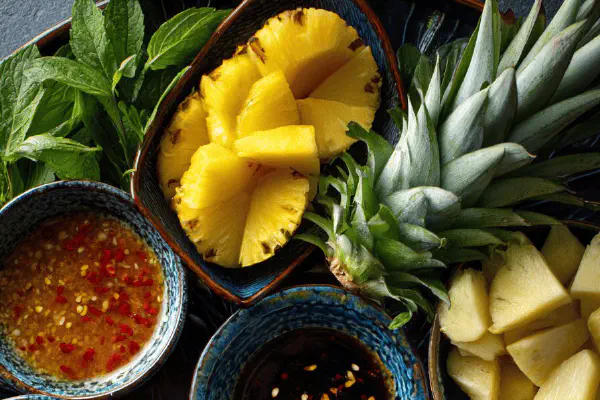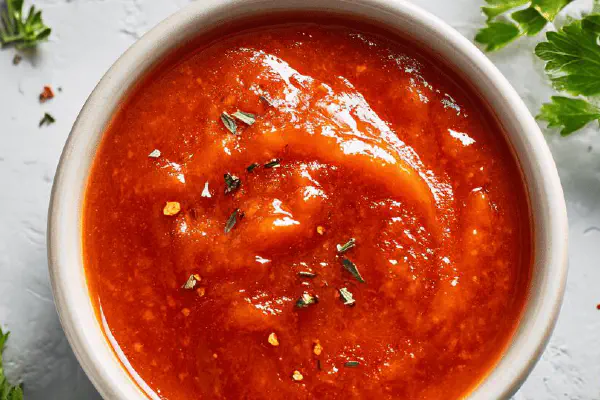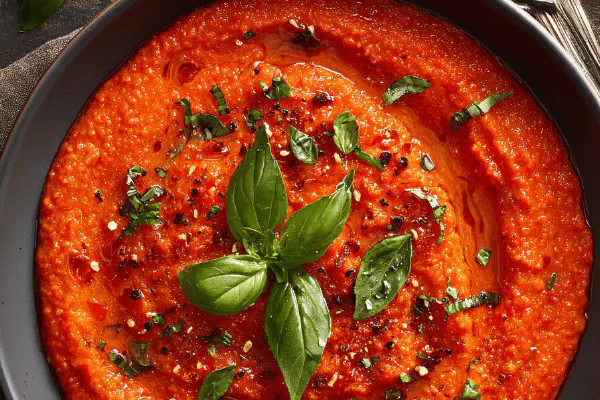Vietnamese Fondue Sauces Remix

By Emma
Certified Culinary Professional
Ingredients
Basic Fish Sauce Blend
- 300 ml water
- 90 ml palm sugar (or brown sugar if unavailable)
- 100 ml fresh lime juice (or white vinegar for sharper tang)
- 140 ml fish sauce (nuoc mam)
Ginger-Chili Sauce
- Basic Fish Sauce Blend as needed
- 5 cm fresh ginger, peeled and pounded
- 5 cloves garlic, minced fine
- 10 ml chili garlic paste (substitute sambal oelek if missing)
Lemongrass-Pineapple-Basil Sauce
- 1 stalk lemongrass, roughly chopped
- 200 ml fresh pineapple chunks
- A handful fresh Thai basil leaves
- Basic Fish Sauce Blend as needed
About the ingredients
Method
Preparing Basic Fish Sauce Blend
- In a sizable bowl, stir together water, palm sugar, lime juice, and fish sauce until sugar dissolves. No heat needed here — the key is complete sugar meld; swirl with a spoon until syrupy. Taste for balance: should be tart-sweet-salty, adjust lime or sugar accordingly. Cold or room temp, flat liquids only.
Ginger-Chili Sauce Crafting
- Throw ginger, garlic, and chili paste into a small food processor or mortar. Blitz or pound until pasty but a little textured, not smoothie. Splash in Basic Fish Sauce Blend gradually, till it hits that punchy salty-sour heat you want. I lean heavier on ginger, sometimes double it if it’s pale or too fibrous. Keep taste buds alert, add more chili paste if you want fire-exhale.
Lemongrass-Pineapple-Basil Sauce Building
- Rough chop lemongrass, toss with pineapple chunks and basil leaves into processor. Pulse just enough to break up but keep fibers visible — you want juicy texture and zesty bits chunky. Stir in Basic Fish Sauce Blend slowly; the pineapple’s juice adds sweetness so temper sugar in base if remaking. Basil lifts it light and fresh, so no over blend. Visually, vibrant green flecks and golden pineapples, aromatic hit of lemongrass.
Final Assembly and Serving
- Set all sauces in shallow dishes next to your hot pot. Use a small spoon or pour over meat or veggies dipped from the boiling broth. Keep sauces chilled or room temp. If fish sauce blend crystallizes (rare but annoying), stir briskly; warm water splash fixes instantly. Adjust chili or lime at the table — personal heat and tang vary wildly.
- I remember once overpounding ginger and garlic — harsh bite, weird bitterness. Key: crush but don’t pulverize. Same with lemongrass: too fine equals woody bits stuck in teeth. Palm sugar versus brown sugar? Palm brings a smoother molasses note, brown sugar more caramel and heavier mouthfeel. Both work. Swap Thai basil for mint if basil lacks; changes flavor but fresh and bright still.
- If no pineapple, canned works, squeeze liquid off first to avoid watering down. Lemongrass can be hard-wired—bash with back of knife before chopping to release oils. If too pulpy, strain with fine sieve but texture fades. These sauces kick the broth up multiple notches. They carry fondue dipping from bland wetness to layered bites elevating meat, tofu, or mushroom.
- Snapping sounds from boiling broth, sizzling veggies, then the sauce taste — sweet-savory shock, ginger tickle, basil burst. The fix for dullness. My workaround with missing ingredients? Lime for vinegar, palm sugar for honey. These sauces aren't just condiments, they’re flavor punchlines to a Vietnamese feast.
Cooking tips
Chef's notes
- 💡 Cold base fish sauce blend only; stir sugar until fully dissolved—swirl slow, feel syrup viscosity. Skipping heat keeps brightness; heat dulls and unbalances flavors. Palm sugar makes syrup smoother, brown sugar adds caramel weight. Lime juice is key for tartness; vinegar works but sharper, adjust sweet carefully.
- 💡 Ginger-chili paste needs crush not puree. Crushed garlic tiny bits, avoid whole chunks that overpower texture and bite. Add fish sauce blend bit by bit, taste constantly for that salty-sour punch. Double ginger if it’s pale, keeps punch alive, watch bitterness if overdone. Chili paste choice matters; chunky texture keeps body and heat balance.
- 💡 Lemongrass prepped by smashing bulky stalk then chopping coarsely. Pulse pineapple and basil but keep visible bits—avoid pureeing into soup. Juice from pineapple adds sweetness; reduce base sugar accordingly. Basil’s herbal pop only fresh, mint swap works but changes profile. Texture contrast sharp between juicy fruit and fibrous lemongrass.
- 💡 If fish sauce blend crystallizes (rare but annoying), stir briskly and splash warm water—fixes instantly. Keep sauces separate from hot broth moisture; watery sauce kills texture and flavor. Store in sealed containers, chill or room temp okay for hours. Adjust lime or chili right before serving, flavors shift fast with heat exposure.
- 💡 Canned pineapple okay but drain juice to avoid watering down. Lemongrass tough fibers needs bashing with back of knife to release oils. Overpounding ginger makes harsh bitterness; too little leaves weak flavor. Balance is subtle—chunky salsa textures important; pasty or puree kills the mouthfeel dynamic. Swap sambal oelek for chili garlic paste to soften rough edges.
Common questions
How to avoid bitter ginger in sauce?
Crush gently, don’t pulverize. Bitterness comes from over-processing. Double ginger only if pale or fibrous. Mix with garlic and chili paste carefully. Avoid full blender puree; texture matters too.
Can I use vinegar instead of lime juice?
Yes but sharper bite. Adjust sugar down if too tart. Lime brighter, vinegar more acidic. Use white vinegar over others. May need extra pineapple juice to balance sharp edges. Personal tweaks recommended.
What if sauce gets watery or diluted?
Keep separate from broth. Drain canned pineapple well. Don’t add water to fish sauce blend, stir until sugar melts completely. If watery, chill for firmness. Stir briskly if crystallized. Last-minute lime or chili adjust before serving.
How to store leftover sauces?
Best sealed container, fridge up to 2 days. Room temp short time okay. Fish sauce blend stable cold or room. Avoid moisture contamination. Stir again before use, chill or warm splash helps dissolve solids. Use fast for freshest punch.



